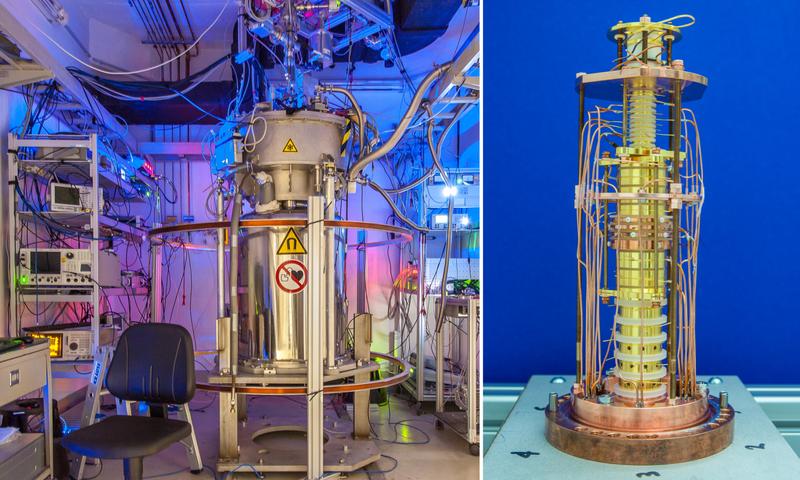

Fig. 1: Alphatrap: on the left the superconducting magnet, on the right the ion trap built into it.
Photo: MPIK
Quantum electrodynamics (QED) describes the interaction of charged particles with electromagnetic fields and is the most precisely tested physical theory. It provides extremely accurate calculations for physical observables and until now no deviation from its predictions has been measured.
Nevertheless, it is of fundamental interest to find the limits where the validity of QED possibly fails – this would pave the way to new physics. One approach is a high-precision test under extreme conditions, i. e. at extremely high field strengths.
Physicists from the division of Klaus Blaum at the Max Planck Institute for Nuclear Physics (MPIK) in Heidelberg have performed such a test by measuring the magnetic properties of highly charged argon ions in the new ion trap Alphatrap with highest precision.
They investigated boron-like argon ions. These are thirteen-fold charged and – like the element boron – possess five electrons. Also, these ions have a much higher nuclear charge of 18 elementary charges (instead of 5 for boron). The electric field of the atomic nucleus to which the outermost electron is exposed is thereby increased by a factor of 900 compared to boron.
The physical observable studied here is the magnetization of this electron, which is determined by the so-called g-factor. The g-factor depends both on the internal angular momentum (spin) and the orbital motion of the electron around the atomic nucleus (orbital angular momentum). Defined as the ratio of the electron's magnetic moment to its total angular momentum, the g-factor is a measure of the strength of the magnetic interaction.
It can be calculated very accurately using QED and it can also be experimentally determined with comparable accuracy. The comparison of theory and experiment therefore provides a highly sensitive test of the bound electron QED.
This was the first experiment using the new double Penning trap Alphatrap at MPIK for the measurement of single highly charged argon ions. The ions are forced by a strong external magnetic field on a circular path (cyclotron motion) around the trap axis. Different voltages can be applied to the set of cylindrical electrodes in order to prevent the ion from escaping along the trapping axis as well as to transport it along the axis. Additionally, applying these voltages allows transporting the ion along the axis in a desired manner.
In the part of the setup called “precision trap”, the cyclotron frequency is measured non-destructively with extremely high accuracy. Simultaneously, microwaves are irradiated, which – at a suitable frequency – can flip the electron's spin direction. If one considers the electron as being a tiny spinning top, it would be turned upside down.
These so-called “spin-flips” occur most frequently in resonance with the microwave frequency. In order to detect such quantum jumps, the ion is transferred into the part of the setup called “analysis trap” where the spin orientation is determined by means of a precise frequency measurement. Thanks to the high precision and stability of the entire setup, this method has been used to precisely determine the g-factor to 9 digits.
To compare the experimental result with the QED predictions, the theory department of Christoph Keitel at MPIK and the group of Dmitry Glazov at St. Petersburg University recalculated the g-factor of boron-like argon. Here, in addition to QED contributions, the interaction with the other four electrons and the recoil of the atomic nucleus were taken into account.
They achieved an accuracy of seven digits and, at this level, the theoretical value is in excellent agreement with the experimental result. It is one of the most accurate tests of QED contributions for multi-electron systems in strong fields and, thus, paves the way for future measurements with Alphatrap. This includes the high-precision determination of the fine structure constant α introduced by Arnold Sommerfeld. Within QED, this fundamental natural constant determines the strength of the electric and magnetic forces.
Dr. Sven Sturm
MPI for Nuclear Physics
Phone: (+49)6221-516-447
E-mail: sven.sturm(at)mpi-hd.mpg.de
Prof. Dr. Klaus Blaum
MPI for Nuclear Physics
Phone: (+49)6221-516-850
E-mail: klaus.blaum(at)mpi-hd.mpg.de
Dr. Zoltán Harman
MPI for Nuclear Physics
Phone: (+49)6221-516-170
E-mail: harman(at)mpi-hd.mpg.de
Hon.-Prof. Dr. Christoph Keitel
MPI for Nuclear Physics
Phone: (+49)6221-516-150
E-mail: keitel(at)mpi-hd.mpg.de
The g-factor of Boronlike Argon ⁴⁰Ar¹³⁺
I. Arapoglou, A. Egl, M. Höcker, T. Sailer, B. Tu, A. Weigel, R. Wolf, H. Cakir, V. A. Yerokhin, N. S. Oreshkina, V. A. Agababaev, A. V. Volotka, D. V. Zinenko, D. A. Glazov, Z. Harman, C. H. Keitel, S. Sturm, and K. Blaum
Phys. Rev. Lett. 122, 253001 | DOI: 10.1103/PhysRevLett.122.253001
https://doi.org/10.1103/PhysRevLett.122.253001 Originalpublikation
https://www.mpi-hd.mpg.de/blaum/index.en.html Division “Stored and Cooled Ions” at MPIK
https://www.mpi-hd.mpg.de/keitel/ Division “Theoretical Quantum Dynamics and Quantum Electrodynamics” am MPIK












